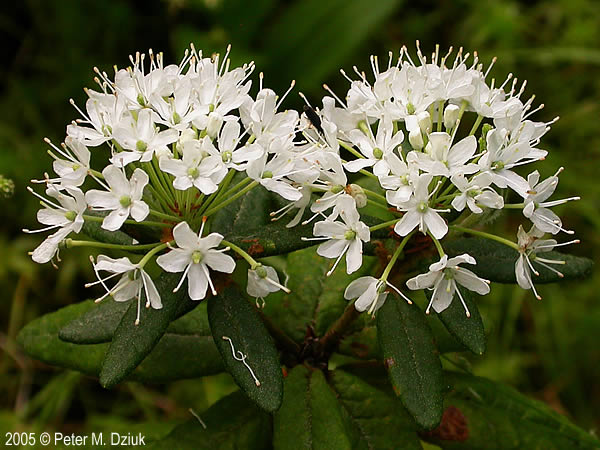
The plant Rhododendron groenlandicum, otherwise known as Bog Labrador Tea, has a long rooted, and important history. The name comes from the Latin word Ledum, classifying that it is a shrub, and its species name “groenlandicum” meaning Greenland, referring to its original territory discovered in the North. The shrub is a native perennial plant that can be found in environments such as bogs, swamps, tundras, fens, and shrub communities in the United States, and Canada. Specifically, you can find these plants in Alaska, Canada, the states of New England, New Jersey, Pennsylvania, North and South Dakota, Idaho, Washington, and Oregon.
Visually, the plant has dense hairy twigs and vines with clusters of dark green leaves and white flowers off the stem. The planted it noted for attracting pollinators. The dimensions of the plant can reach up to three feet tall and have multiple stems. The stem structure in the Bog Labrador Tea plant is able to reproduce itself with its rhizome structured roots and crowns. The shrub has many beneficial uses, and is an important species of plant to our planet. The Bog Labrador Tea leaves are smelly and fragrant, commonly used as a beverage and medicine by historical tribes and still occasionally today.
Edward Umfrewill, in 1790 wrote about its uses in historical times noting its many great uses. It has a pleasant aroma about it, strengthens the stomach, relieves pains in the head, and also promotes perspiration. The shrub can be turned into a powder for more concentrated uses. Medicinal uses back then did not stretch too thin, tribes would use the leaves to medically treat problems such as inflammatory issues like asthma and burns. (U’mista Cultural Society et al. 1998; Gunther 1973) A tribe called Ojibwa used the shrub as a medicine to treat ulcers, along with other tribes using it as blood purifiers to help clean out the respiratory system. It is important to note that the tea may be toxic in concentrated doses, due to the fact it contains toxic alkaloids that are poisonous to animals and humans. (Pojar and MacKinnon 1994). An important property of the shrub is its oil. Today, there is a demand for the plants oils for aromatherapy uses, besides the oils the use of the plant as a beverage became most popular and was quickly adapted by Europeans and foreigners due to its flavor and taste. Historically, tribes would pick the leaves year round. However, the Ojibwa tribe specifically would pick them from the seasons of spring to autumn in order to make the beverage tea. An interesting note about the leaves is that they can be used fresh, or dried over some time.
Brandon Yaroma
Works Cited:
- Anderson, M., 2011. Plant Guide for bog Labrador tea (Ledum groenlandicum). USDA-Natural Resources Conservation Service, National Plant Data Team. Greensboro, NC.
- Gunther, E.. 1973. Ethnobotany of Western Washington: The Knowledge and Use of Indigenous Plants by Native Americans. Seattle: University of Washington Press.
- Janice Schofield, Alaska Northwest Books, 1989; ISBN: 0- 88240-369-9
- Pojar, J. and A. MacKinnon (eds.) 1994. Plants of the Pacific Northwest Coast: Washington, Oregon, British Columbia & Alaska. Lone Pine Publishing, Vancouver, British Columbia.
- Umfreville, E. 1954. The Present State of Hudson’s Bay Containing a Full Description of that Settlement, and the Adjacent Country; and Likewise of the Fur Trade. The Ryerson Press, Toronto, Canada.U’mista Cultural Society, J
- William Miller Ledum latifolium (Rhododendron groenlandicum) from “The Botanical Cabinet” (London) 1817-1833) plate 534

Great job of giving detailed information about the history and description of the species, also I really like the layout of the blog as a whole… Great job.
LikeLiked by 1 person
This was a very informative article! Have never heard of the Bog Labrador Tea before reading this article, but now I’m very informed as to what it is. I find it to be really cool that the plant can be found in many states in the U.S., and that it can be used for numerous medical ailments. Very nice written!
LikeLike
Brandon, wow!
Nice post, very informative. Maybe we can find some of these in our backyard.
LikeLike
This was a very informative article. Prior to reading, I had never heard of the Bog Labrador. However, I now feel that i could spot one on site. I also like how you included the history of the plant because I found that very interesting as well.
LikeLike
Brandon, great post.
You did a nice job giving a detailed description of the species, where it can be found, and some benefits it has towards humans.
LikeLiked by 1 person